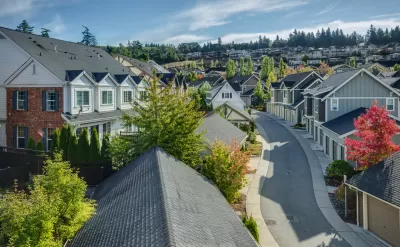Neighborhoods with preexisting internal contracts are exempted from new legislation requiring all Washington cities to permit duplexes and other ‘missing middle housing.’

Earlier this year, the Washington state legislature passed legislation aimed at eliminating single-family zoning and creating more diverse and abundant housing options in the state. However, as David Gutman and Daniel Beekman report in The Seattle Times, “homeowner associations and other ‘common interest communities’ that have internal contracts or documents governing their zoning rules” are exempt from the new law, effectively allowing them to remain exclusively zoned for single-family homes.
“Because homeowner associations and common interest communities have preexisting, legally binding contracts regarding their zoning rules, the Legislature can’t change those, said Rep. Jessica Bateman, D-Olympia, the bill’s lead sponsor,” explaining the exemption. “The bill does explicitly bar homeowner associations from making new contracts or agreements to try to prohibit duplexes and other kinds of middle housing. But it only applies to future agreements, those enacted after the law becomes effective.”
According to University of Washington law professor Hugh Spitzer, “people can put restrictive covenants on their properties and you can’t have a law that comes in and wipes that out,” except in the event that the law is related to safety, such as the requirement to add a fire escape. Yet state law does, as Gutman and Beekman point out, govern some aspects of homeowner association rules, including legislation that bans HOAs from prohibiting certain flags, political signs, and solar panels.
The authors remind readers of the sordid history of HOAs. “In Seattle, and across the country, many homeowner associations were created a century ago for the express purpose of excluding racial and religious minorities.” The article continues, “These are the same communities that today won’t be touched by middle housing, which supporters of HB 1110 say can diversify neighborhoods by providing options at different price points.”
FULL STORY: WA’s new ban on single-family zoning exempts some of Seattle’s wealthiest neighborhoods

Planetizen Federal Action Tracker
A weekly monitor of how Trump’s orders and actions are impacting planners and planning in America.

Chicago’s Ghost Rails
Just beneath the surface of the modern city lie the remnants of its expansive early 20th-century streetcar system.

San Antonio and Austin are Fusing Into one Massive Megaregion
The region spanning the two central Texas cities is growing fast, posing challenges for local infrastructure and water supplies.

Since Zion's Shuttles Went Electric “The Smog is Gone”
Visitors to Zion National Park can enjoy the canyon via the nation’s first fully electric park shuttle system.

Trump Distributing DOT Safety Funds at 1/10 Rate of Biden
Funds for Safe Streets and other transportation safety and equity programs are being held up by administrative reviews and conflicts with the Trump administration’s priorities.

German Cities Subsidize Taxis for Women Amid Wave of Violence
Free or low-cost taxi rides can help women navigate cities more safely, but critics say the programs don't address the root causes of violence against women.
Urban Design for Planners 1: Software Tools
This six-course series explores essential urban design concepts using open source software and equips planners with the tools they need to participate fully in the urban design process.
Planning for Universal Design
Learn the tools for implementing Universal Design in planning regulations.
planning NEXT
Appalachian Highlands Housing Partners
Mpact (founded as Rail~Volution)
City of Camden Redevelopment Agency
City of Astoria
City of Portland
City of Laramie





























